Citation with persistent identifier:
Fappas, Yannis. “Archaeology Through Archives: The Early History of the Archaeological Research in Boeotia Through Original Historical Archives.” CHS Research Bulletin 5, no. 2 (2017). http://nrs.harvard.edu/urn-3:hlnc.essay:FappasY.Archaeology_Through_Archives.2017
Ἡ βίβλος αὕτη τῇ φαεινῇ Καδμείᾳ κλέος προσάπτει, ἐπὶ προγόνων μνείᾳ.
Thebes, September 14, 1894. The Ephor, Eukleides Vagiannes.
1§1 The above epigram comes from the very first page of the catalogue of the first organized collection of Boeotian antiquities, compiled by the Ephor Eukleides Vagiannes, philologist in profession and one of the pioneers of archaeological research in Boeotia, at a time when archaeological research in Boeotia was still in its infancy, and the Archaeological Museum of Thebes did not yet exist. This epigram of the Ephor Vagiannes incorporates in just a few words the ultimate ideology of all those people involved in archaeological research in nineteenth-century Boeotia, who were motivated by their love for the legacy of their ancient ancestors and the desire to collect, secure, and preserve for future generations every single piece of the ancient glory of Thebes.[1]
1§2 The great traveler of the early nineteenth century, William Martin Leake, who was a British lieutenant-colonel and for many years official delegate of the British government in Greece, recites that at his time “at Thebes, as in most of the towns of Greece, which continue to occupy their ancient cites, the remains of antiquity chiefly consist of fragments of architecture and sculpture, or of inscribed marbles, dispersed among the houses, mosques, baths, and fountains, in the walls, stairs, streets, and pavements. Not one of the ancient buildings can be traced; though it is very possible that some remains of them may be mixed with the modern structures, or buried by them, and that on the site of Lower Thebes to the southward of the town, where they are more accessible, many other valuable remains may still subsist below the surface of the soil.”[2] Leake’s observations on Thebes’ general picture and the state of Theban antiquities in the early nineteenth century were confirmed about thirty years later by Ludwig Ross, who arrived at the town of Thebes with King Otto, as an escort of the young monarch.[3] The overall situation did not change much for many years to come, as confirmed by Georgios Soteriades in the early twentieth century (Figure 1).[4]
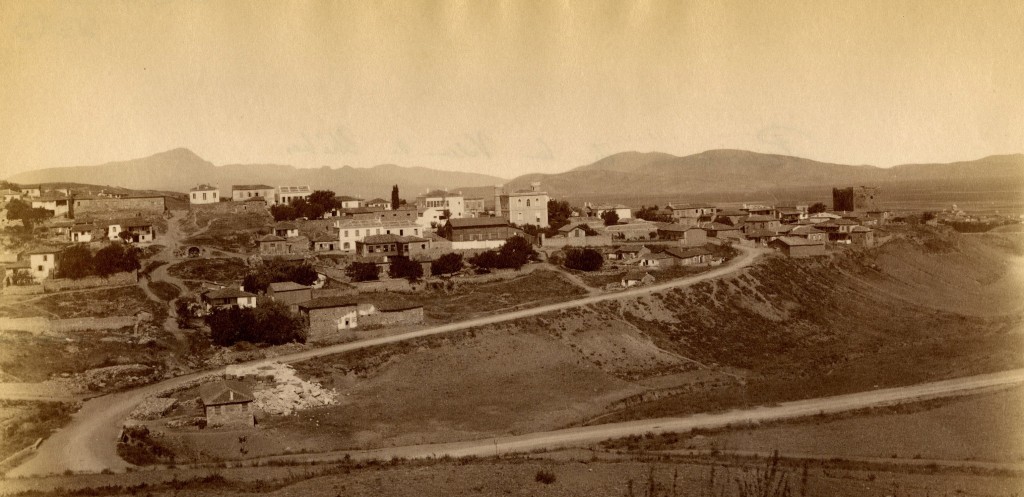
1§3 The fascinating story of archaeological research in Boeotia[5] starts immediately after the end of the Greek War of Independence, when Boeotia became one of the most important regions of the newly formed kingdom. Its ancient legacy, full of myths and traditions,[6] together with the scattered remains of a glorious past, attracted scholars and amateurs and urged them to reveal, study, preserve and secure its numerous antiquities, visible or otherwise. Thus began the long and fruitful tradition of archaeological research in Boeotia, in which some of the most pioneering and emblematic figures of Greek and international archaeology played a key role, followed by the attempt to establish a pan-Boeotian Museum in Thebes, the region’s historically most famous city.
1§4 The first organized attempt to rescue the scattered antiquities in the Greek provinces and to establish archaeological museums in various Greek cities dates early on, back to the years of the War of Independence, when one of its most emblematic figures, Gregorios Dikaios (Papaflessas), serving as a minister of Internal Affairs, issued a decree on February 10th, 1825,[7] instructing the local authorities of the Greek cities to gather all movable antiquities (coins, sculptures, inscriptions) and keep them in the schools, so that every school could have its own museum in the future.[8] We can now consider this official order as marking the beginnings of modern archaeological research in Boeotia, as well as in the rest of Greece.
1§5 According to the state documents that have survived in the General State Archives, the actual archaeological research in Boeotia was begun a few years later, after the establishment of the modern Greek state in 1830, by the painter Athanasios Iatrides, a curator of the first National Museum at Aegina and a member of the first Archaeological Service.[9] The German philologist Ludwig Ross, initially Ephor of the Peloponnesian antiquities (1833-1834) and later General Ephor of Antiquities (1834-1836),[10] writes that Iatrides was the one who established and supervised the first archaeological collection in Thebes, the initial core of the city’s current Archaeological Museum.[11]
1§6 Ross’s reference to Iatrides’ work at Thebes and to the establishment of an archaeological collection in the city should be related to a trip by Iatrides to central Greece in July of 1835, at a time when he served as Ross’s assistant in Athens. This trip was part of an official tour, on which Iatrides was sent together with the architect Laurent, to collect and draw various monuments, as mentioned in a ministerial document signed by Iakovos Rizos Neroulos on July 10th, 1835. Through this document, the minister orders the local authorities to help the two travelers and ensure their access, wherever needed, to old churches or other buildings for the temporary storing of antiquities.[12]
Looking for the ancient topography of Thebes
2§1 The first steps of archaeological research in Greece coincided with the time when European philhellenes, scholars, and artists[13] investigated the ancient Greek civilization, which they regarded as a source of inspiration and creation. Thus, they responded in a sense to Winckelmann’s call, asking them to be taught by the beauty and superiority of ancient Greek art and to imitate it creatively.[14] For the European philologists-classicists in particular, who admired Greek antiquity, the material remains of the ancient Greek past were connected with personas and facts described by ancient writers; i.e. they were regarded as illustrations of ancient literature, thus testifying to the truth and precision of descriptions found in ancient texts.
2§2 At the same time, in the first decades of the 19th century, a realistic trend prevailed in travelling tours in Europe. In contrast to former periods, the interest was now turned to natural phenomena and geographical features, flora and fauna, mineral and ore sources, modern population and cultural habits (F.C.H.C. Pouqueville, E. Dodwell et al.). Thus, while also drawing ruins and landscapes, travelers started recording their observations on farming occupations, water resources, phenomena of soil erosion, demographic numbers, but primarily tried to record and spatially define the ancient monuments within the modern natural landscape. This was the great contribution of William Martin Leake, the traveler who, like Pausanias in antiquity, toured Greece and collected very significant information on both modern Greek life and the state of its ancient monuments – a ‘Columbus of the ancient world’, as Ernst Curtius called him later.[15]
2§3 Leake visited Thebes and the rest of Greece in the first decade of the 19th century. In his work Travels in Northern Greece, published several years later, he described the modern town of Thebes and its dispersed monuments, while also referring to the town’s inhabitants and their occupations. At the same time, he tried to recreate Thebes’ ancient topography around the Kadmeia hill, based on descriptions by Pausanias, Dikaiarchos and other ancient writers, as well as his own observations on the landscape’s features.[16] In fact, he accompanied his extensive report on Thebes’ ancient topography with a map of the ancient town upon which he pinpointed hypothetical location of various landmarks and monuments (Figure 2).
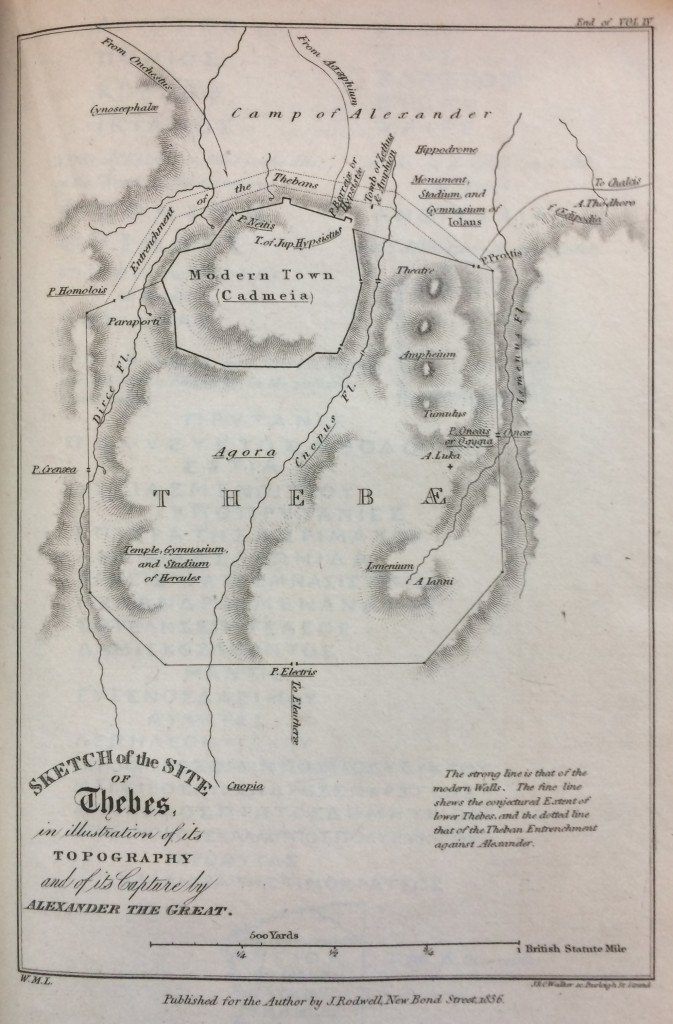
2§4 This trend towards realism, characterizing the most significant travelling tours in Greece in the first half of the 19th century, prevailed in European philology at this time, too, with August Boeckh, professor at the University of Berlin, as its main representative. This trend reflected the attempt to represent the real world of ancient classical writers, i.e. the historical environment and the social and economic circumstances under which they lived and created. This approach to the study of ancient texts required the combined examination not only of ancient sources, but also of all kinds of archaeological remains, architectural monuments, inscriptions, coins and other finds.[17]
2§5 Boeckh’s student, Karl Otfried Müller, followed the same trend, while he additionally introduced to the field the concept of spatial study, i.e. “the exact knowledge of the ground and its monuments” according to his own student Curtius, thus combining classics with geography. He also believed that to study a people one first needs to study the place where this people lives, following Humboldt’s and Ritter’s theories that a country’s climate and ground morphology play a decisive role in defining its people.[18] This view was in fact applied by Müller to his first great study on the Minyans, the mythical inhabitants of Orchomenos in Boeotia[19], which he mentally visited both through information that he personally collected and through other travelers’ reports.[20]
2§6 Müller’s approach led to a totally new view of Greece and Greek history. From then on, two new elements were required: the visualization of ancient landscapes through the compilation of maps and the personal visit to places of interest for the study and recording of their ancient environment. In fact, the establishment of Othon’s monarchy increased the possibilities for the accomplishment of such projects, especially allowing German scholars to carry out scientific studies and trips throughout the freed country.[21] The land of Boeotia, which had such a rich mythological and historical tradition and was so many times mentioned in the work of ancient writers – poets, historians, travelers – was an important pole of attraction for many of them.
2§7 The following are some of the first and most important German scholars with such a background who came to Greece and studied ancient topography: the great Philhellene and philologist Friedrich Thiersch; Ludwig Ross, general ephor of antiquities and professor of archaeology in Athens and later in Halle; Heinrich Nikolas Ulrichs, Thiersch’s student and professor of Latin in the first university of Athens; Peter Wilhelm Forchhammer, a politician and humanist, professor later in Kiel; Conrad Bursian, Boeckh’s student and later professor of philology and archaeology in the universities of Tübingen, Zurich, and Jena; Ernst Curtius, archaeologist and Müller’s student; the archaeologist and historian Ernst Fabricius, who later became a member of the Athens Archeological Society, and above all the great Hellenist, professor at the universities of Goetingen and Berlin, Ulrich von Willamowitz-Möllendorff.[22]
2§8 Thus, the first years of archaeological research in Boeotia were mainly marked by the intense interest of several known European philologists-classicists in Thebes’ ancient topography. These scholars, guided by the traveler Pausanias and other ancient writers and led by the spirit of modern Romanticism, were motivated by the idea/wish to locate and identify various landmarks of the city mentioned in ancient texts. Among these sites were the famous “seven gates”, the “source of Ares”, the “tomb of Zithos and Amphion, the “Syrma of Antigone”, the sanctuaries of Apollo and Herakles, the two rivers Dirke and Ismenus.[23] The first scholar who synoptically refers to the topography of ancient Thebes was, in fact, Ludwig Ross, who visited the town with King Othon from the 14th to the 16th of September, 1834, escorting the king on his trip to the cities of central Greece.[24] He actually identified the location of “Kadmeia” under the then-provincial town of “Phiva”, upon the tall oblong hill that is surrounded by the torrents of Dirke and Ismenus, but also in the flat land extending to its north.[25]
2§9 The first scholar, however, who travelled to Thebes with the exclusive aim of investigating it and understanding its ancient topography, was the German philologist and Latinist, one of the first professors of the University of Athens, Heinrich Nikolas Ulrichs, visiting in 1840, who wrote a relevant monograph entitled Topographie von Theben (München 1841).[26] He himself walked a lot in the area of the ancient city and the surrounding hills. He understood the area’s modern topography and tried to recreate its ancient landscape with his imagination, based exclusively on ancient sources, while he set the ancient city’s boundaries around the hills of Kadmeia, Ampheion and Kastellia. The map that he compiled is, in fact, the earliest attempt of modern research to pinpoint the location of some of the greatest landmarks of Thebes known from the mythological tradition (Figure 3).
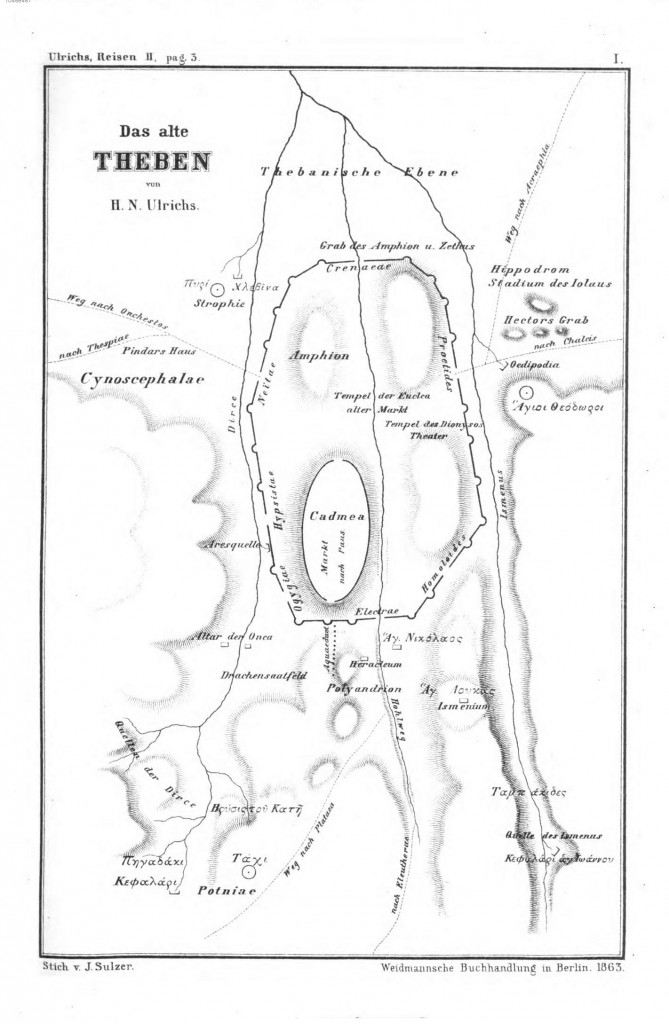
2§10 In 1853, Thebes was visited by the German philologist and archaeologist Conrad Bursian, who travelled around Greece in those years in order to write a monograph on ancient Greek geography, in full accordance with the theories of August Boeckh and Karl Otfried Müller.[27] Bursian gave an extensive report with comments on Thebes, in which he generally accepted Ulrichs’ view that the ancient city occupied the place of Kadmeia, but also extended to the flat area to its northeast, around the hills of Ampheion and Kastellia. However, he did not compile a map.[28]
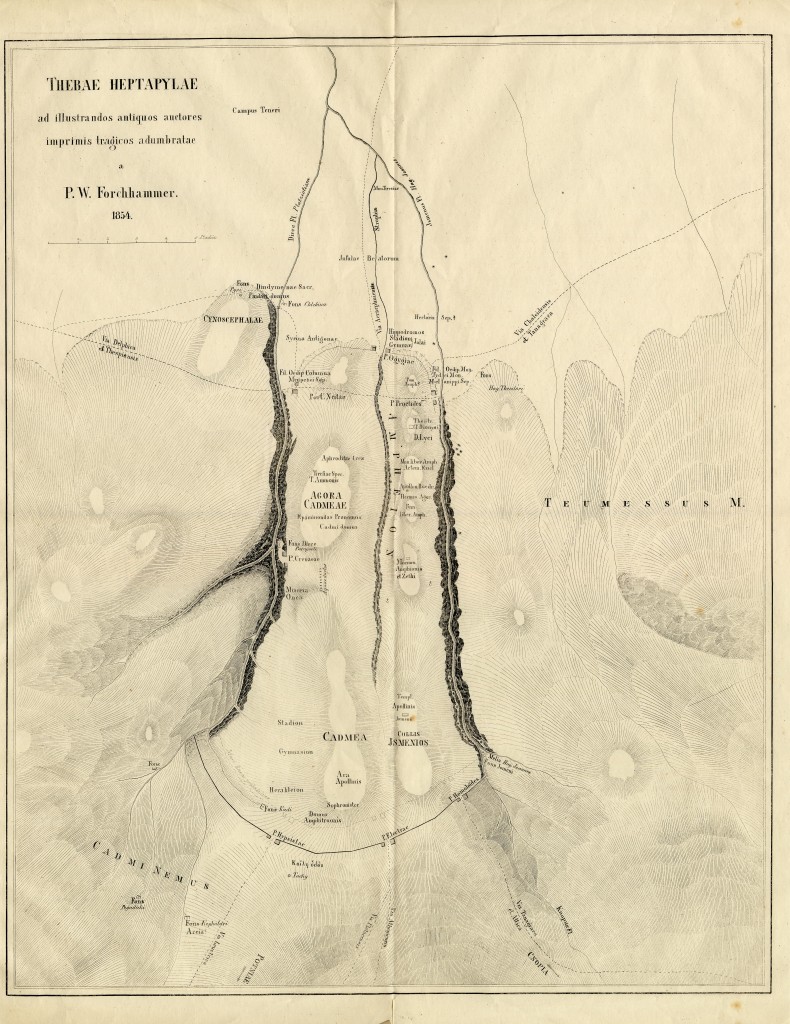
2§11 Peter Wilhelm Forchhammer also studied the ancient topography of Thebes at that time, and Ernst Fabricius did the same somewhat later. These two, like Ulrichs before them, composed their own monographs and compiled their own maps, as was thought necessary at the time. Forchhammer, in a treatise written in Latin and entitled Topographia Thebarum heptapylarum (Kiel 1854), extended the limits of the ancient city to the east and west up to the torrents of Ismenus and Dirke respectively, but also somewhat to the south, thus including the hills of Ismenion and Kolonaki inside the city’s boundaries (Figure 4).[29] Fabricius, who visited Thebes twice, in 1885 and 1888, in his own study entitled Eine Untersuchung über die Topographie und Geschichte der Hauptstadt Böotiens (Freiburg 1890) included a large part of the hills extending to the west inside the city’s walls. Beyond that, he generally followed Ulrichs’ suggestions (Figure 5).[30] Finally, in his essay entitled Die Sieben Thore Thebens (1891), Ulrich von Willamowitz-Möllendorff tried to overturn Ulrichs’s and Fabricius’s views. He himself also visited the area, and thought that the boundaries of the city did not extend beyond the two rivers, Ismenus and Dirke, running to the east and west.[31]
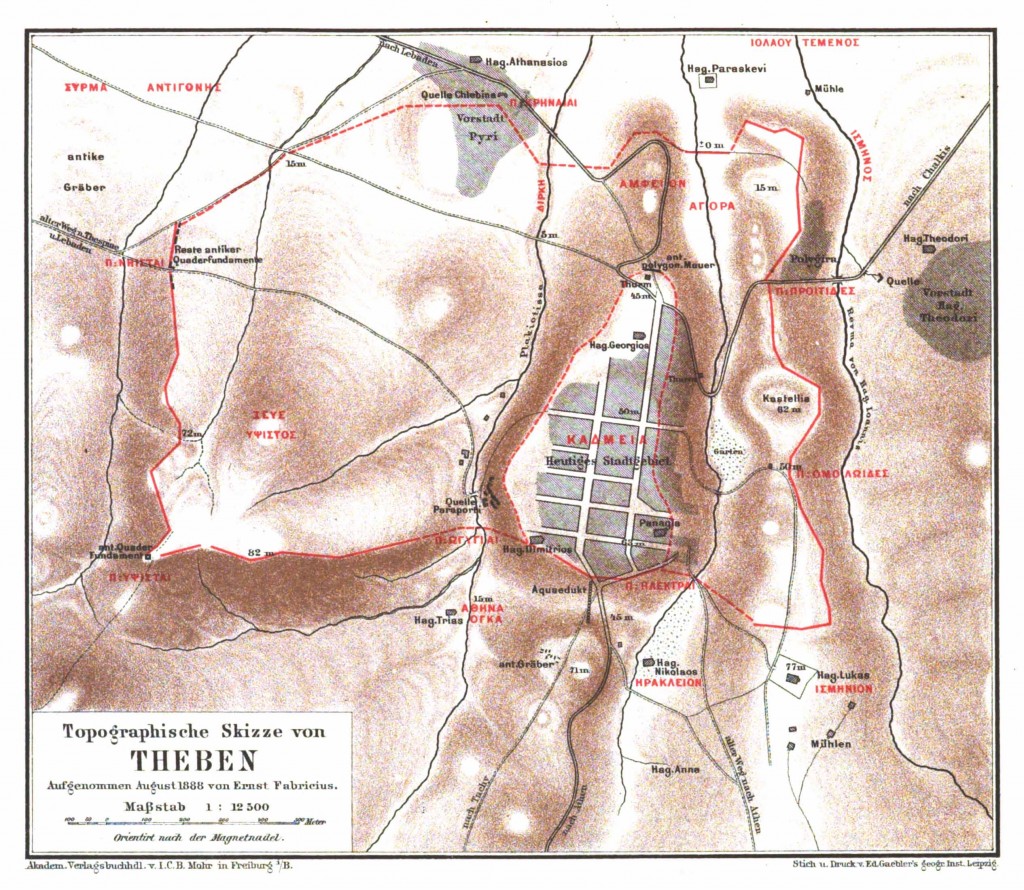
2§12 The year 1891 was critical for the history of archaeological research in Thebes. That was the year of the first systematic excavations in the town. The Theban lawyer Eustratios Kalopais, motivated by his love for his hometown and his interest in Thebes’ ancient history, and funded by the Athens Archaeological Society, voluntarily took up the excavation of the area so as to locate the ancient city’s fortification wall.[32] He had personally shown the walls to various visitors in the past, [33] as he had done in 1885 when he showed scattered fortification remains to Fabricius,[34] who actually compiled a relevant map based on what he saw. Now it was time for him to conduct an excavation himself to confirm his observations. Kalopais had possibly shown the remains of the walls to Willamowitz-Möllendorff, too, and he might have been moved to conduct his own excavation by the latter’s refusal to accept that these were truly the remains of the city’s ancient fortification walls.[35] Fabricius, too, had not been entirely convinced about the fortification’s extent.[36] In any case, the chronological coincidence of Kalopais’s excavations and Fabricius’s and Willamowitz-Möllendorff’s visits to Thebes must not be without significance. The same applies to the writing by G. Pagidas of a PhD thesis on this subject at the University of Strasbourg in 1882, under the supervision of Professor Adolf Michaelis (Figure 6).[37]
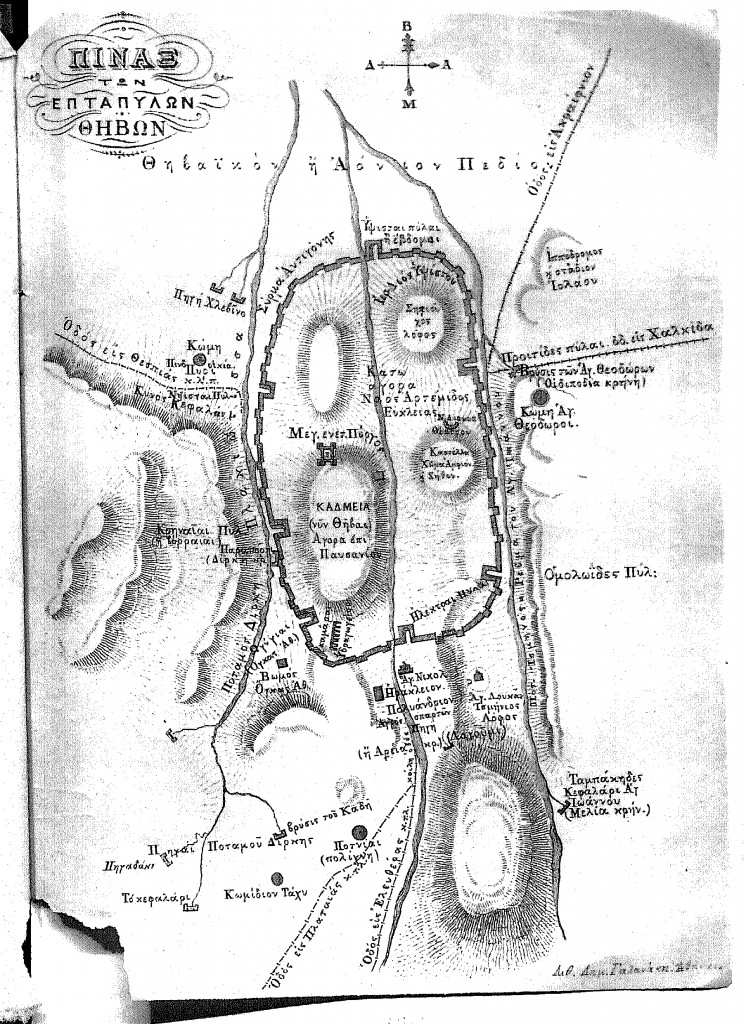
2§13 The town’s people had long known that there were fortification wall remains on the northern and the western side of Thebes, and the local press demanded that the mayor of Thebes approve through the town’s council an amount of money to cover the excavation costs, with the support of the Archaeological Society if need be.[38] Kalopais’s excavation was apparently carried out in this context, but the locals did not show much respect for his discoveries, since parts of the revealed walls were soon robbed by people looking for stones suitable for the construction of houses and other buildings.[39]
2§14 Kalopais’s excavations started timidly in 1891 and carried on with some interruptions until 1893. Funded by the Archaeological Society, to which he regularly sent his financial reports,[40] Kalopais hired a few workers to carry out his excavation at a slow pace and with much care, in such a way as to be able to watch over it himself up close.[41] However, too enthusiastic and eager to locate the wall and the gates, he incurred additional expenses amounting to double the credit that he received from the Society.[42] He also wanted to carry on with his excavation after 1893,[43] but he died in the following year.
2§15 Kalopais’ excavations were carried out through test trenches at various locations where he himself had observed remains of the fortification wall circuit. Thus he uncovered parts of the southern branch of the city’s external fortification wall, to the east and west of Kadmeia,[44] but also sections of the northern branch of the wall at various spots north of the railway line.[45] In addition, after the groundbreaking for Thebes’ railway station, Kalopais carried out the first rescue excavation there to investigate the ancient building remains that had been uncovered, thinking that they belonged to a building with a stoa that would part of Thebes’ ancient agora.[46] In the wider area to the northeast of Kadmeia, Kalopais also dug some test trenches and found various archaeological remains.[47]
2§16 Dimitris Filios,[48] in 1892, and Georgios Soteriades the following year visited Kalopais’s excavations as representatives of the Archaeological Service. Soteriades found Kalopais’ discoveries convincing and accepted his opinion about the location and the extent of Thebes’ external fortification wall.[49] In the same year, he presented the new data in three successive papers in the journal of Εικονογραφημένη Εστία.[50] Soteriades revisited Thebes in 1898 and, with the help of Michael Khrisokhoos, he drew an updated topographical map of the ancient city, based on the new finds of Kalopais’s excavations, on Fabricius’s older map, and on his own on-site observations.[51] He first published this map in Parnassus[52] and then in his study on the topography of ancient Thebes, entitled Περί της τοπογραφίας των αρχαίων Θηβών (Figure 7).[53] In spite of Gomme’s later proposal that placed the fortified city of classical times to the north of Kadmeia (Figure 8),[54] mainly based on Wilamowitz’s views, Soteriades’s map was widely adopted and became the basis for later studies on this subject[55], as well as for maps published in various tourist guides of the early 20th century (Figure 9).[56]
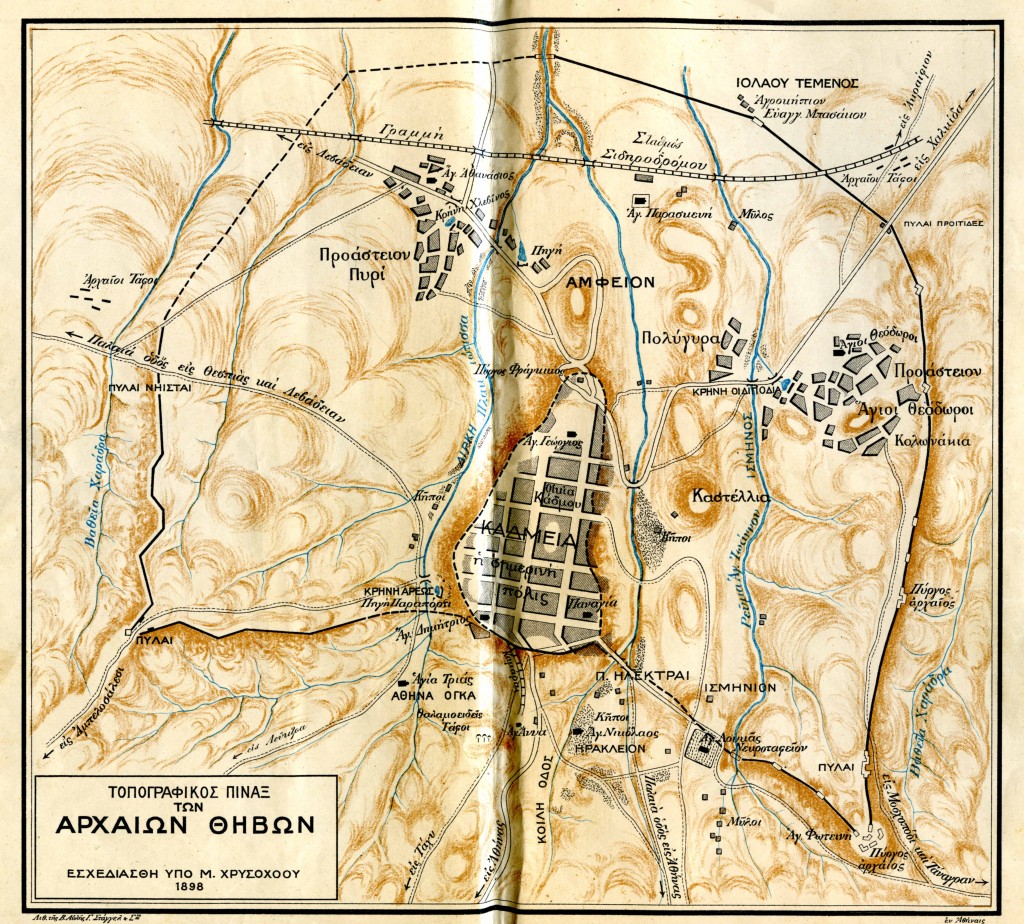
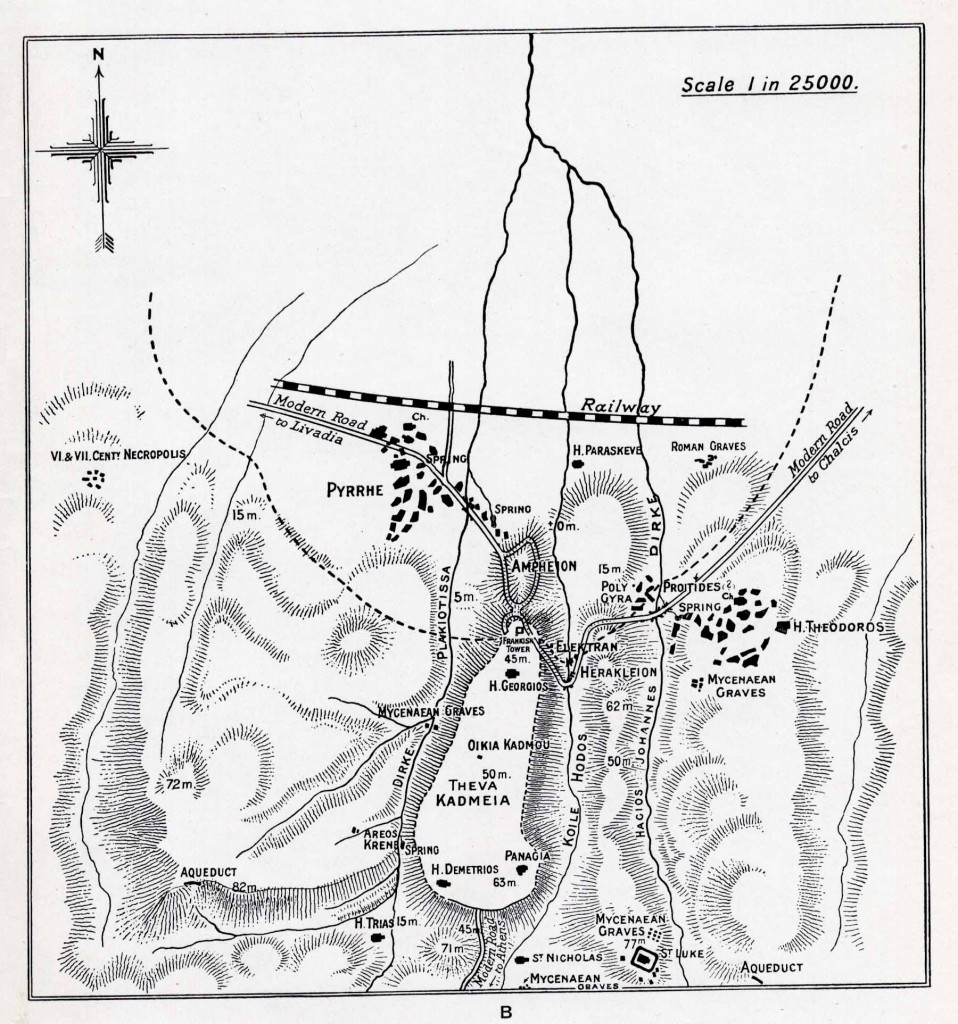
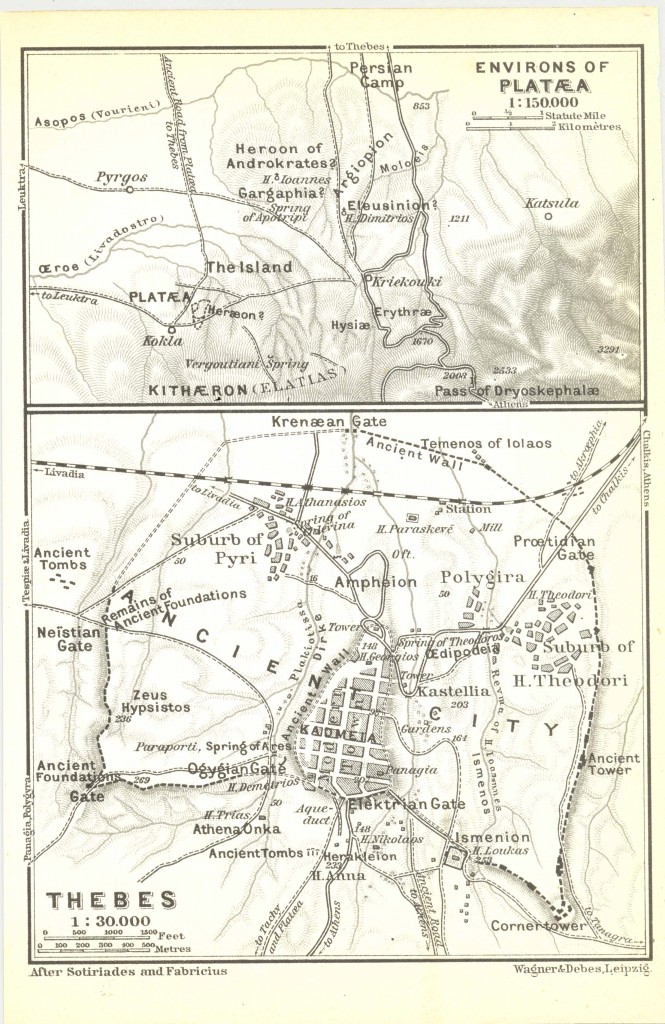
2§17 Eustratios Kalopais was thus one of the pioneers of archaeological research in Thebes. We don’t know the exact date of his birth, nor do we have a picture of him, but we do know that his activity falls in the second half of the 19th century and that he passed away in 1894.[57] He was a Theban lawyer and notary and one of the most prominent members of the local community of Thebes. He was also the one who in 1891 undertook the first excavations in Thebes in order to find the traces of its ancient external fortification wall. Moreover, he was a pioneer in collecting antiquities in Boeotia, thus rescuing them from illegal traffickers. The antiquities collected by E. Kalopais and other pioneers were housed in the old school of the city. Kalopais was in charge of this collection, for which he directly referred to the Athens Archaeological Society. This collection later became the core of antiquities exhibited in the so-called “first archaeological museum” of Thebes, which was established in the city in 1894. In the Theban press of the 19th century we can find a lot of original and very interesting information about his professional, social, and archaeological activity in Thebes of that period. Thus we know that, as part of his social activity, he very often delivered lectures on Greek history to the people of Thebes without expecting any payment.
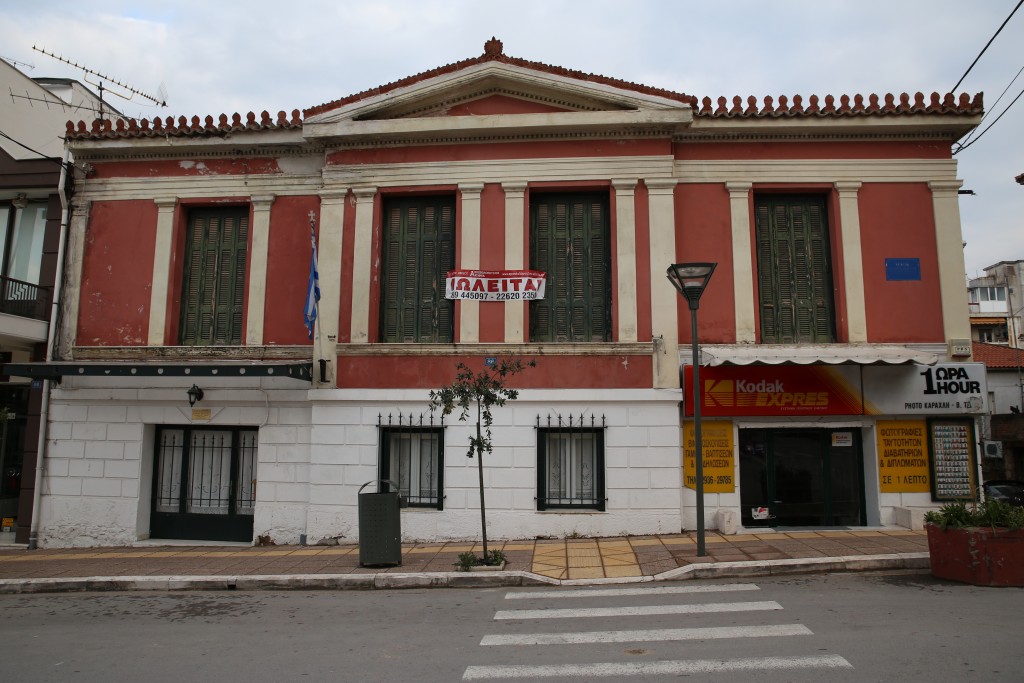
2§18 Both Kalopais and his house, which still exists in the center of the Kadmeia acropolis, at the most prominent location of modern Thebes (Figure 10), are closely connected to the history of archaeological research in Boeotia. We don’t know when this house was built, but it appears in photographs in 1878, whereas the earliest reference to it dates one year earlier, to 1877. In this house, Eustratios Kalopais used to welcome and offer hospitality to many Greek and foreign scholars who visited the city in order to see or study its antiquities. We are certain that Stephanos Koumanoudis, Spyridon Fintiklis, and Panagiotis Eustratiades, pioneers of Greek archaeology, were offered hospitality in this house in 1877,[58] and it is also possible that Fabricius and Villamivitz-Möllendorf stayed in the same house in 1885, 1888, and in 1889 respectively, when they visited Thebes in order to examine its ancient topography.[59]
The Archaeological Society at Athens and the Theban pioneers
3§1 Nineteenth-century Boeotia was one of the regions that suffered severely through illegal excavations, looting, and trafficking of antiquities. The Mycenaean cemeteries of Thebes and the Mycenaean and Classical cemeteries of Tanagra were exposed to looters and Boeotian antiquities were sold in the central markets and streets of many European capital cities. This was actually an activity which had begun in antiquity and continued intensively until the beginnings of the 20th century, thus largely distorting our picture of the wealth deposited in Boeotian cemeteries. The rich tombs constantly attracted looters who passed stolen antiquities on to various markets with fake provenances, so as to profit from the fame and high price of objects from famous sites excavated by Heinrich Schliemann.[60] Antonios Keramopoullos, the first Ephor of the Archaeological Museum of Thebes, vividly describes the situation: “… the burial offerings were most probably dispersed to the ends of the earth as ‘Mycenaean’ works and finds coming from other Greek places, whose glory added to the value of the merchandise after Shliemann’s work … If these Theban finds had been sold as Theban, we would have been impressed by their fame since long ago, and since long ago archaeologists’ attention would have turned to Thebes as a rich Mycenaean centre”.[61] Therefore, it is rather possible that many Mycenaean objects of burial provenance, which are kept today in several archaeological museums and collections over the world and are of unknown provenance or falsely attributed to Mycenae, Tiryns, Troy, etc, come in fact from Thebes.
3§2 Over all these years the Archaeological Society, one of the older intellectual institutions in Greece, established in Athens in 1837,[62] remained active in the field of archaeological research not only in Athens but also in the Greek countryside, especially by sending representatives to almost every province in order to rescue and secure the antiquities from illegal looting. The role of the Archaeological Society in rescuing antiquities was widely recognized especially in Boeotia, since, unlike in other regions, many local monasteries and people of Boeotia contributed a significant amount of money every year to the institution in order to help it achieve its goals.[63]
3§3 In 1871, the Archaeological Society asked the Greek government for permission to appoint Ephors of Antiquities, who would be responsible for the ancient monuments, to the various provinces.[64] Panagiotes Stamatakes, one of the first two Ephors, immediately started his activity in Boeotia and the neighboring areas.[65] A couple of years later, in 1873, an Archaeological Commission for local antiquities appears to have been established at Thebes.[66]
3§4 According to various sources, the Theban collection, which by 1876 numbered some 165 objects, was initially kept at “an appropriate place”, which in 1881 was referred to as a hired private house. Later sources testify that the collection was housed in a room underneath the Boys School. It was first curated by Kalopais and then by Epameinondas Koromantzos (1829-1909), who came from Gortyna and served for many years in Thebes as a teacher, Ephor of Antiquities of Boeotia, and curator of the museum of antiquities of the Syllogos Filoproodon ho Epameinondas Association (Figure 11). By 1885, the collection’s rough catalogue listed some 280 sculptures and inscriptions. There are several references to this collection up until 1904, when the Archaeological Society announced the construction of a museum in the city, which was inaugurated in 1905 by the Ephor Antonios Keramopoullos.[67]
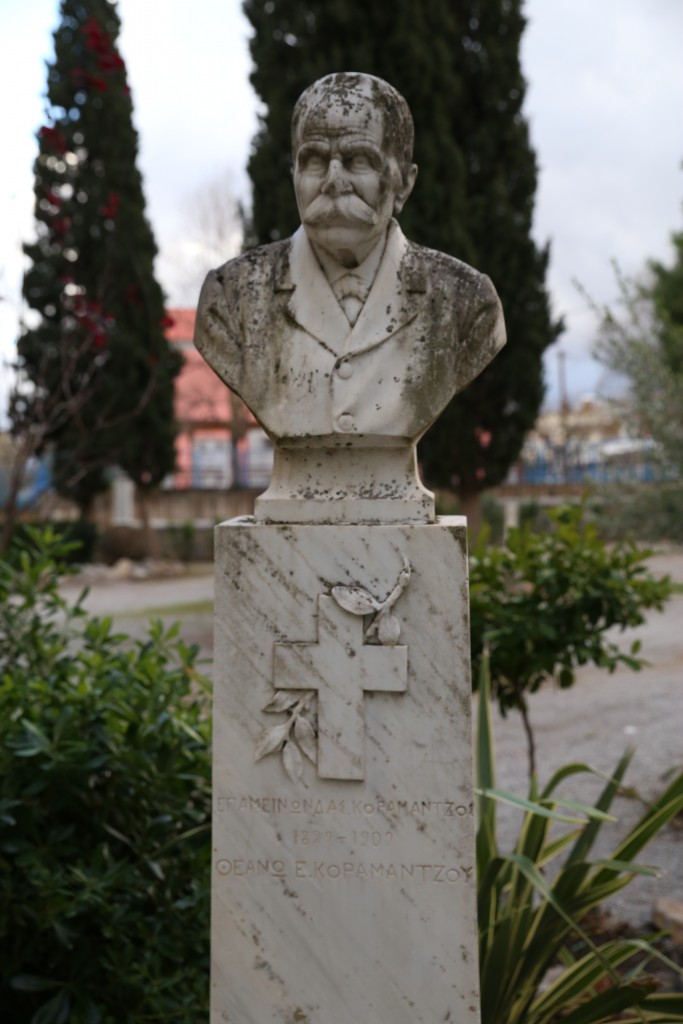
3§5 In the Theban and the Athenian press, as well as in reports of archaeologists and various other sources of those days, one can find a good deal of information about the people who were involved in the field of archaeological activity and research in Boeotia. To the names of Eustratios Kalopais and Epameinondas Koromantzos, we can also add those of Loukas Mpellos, Epameinondas Papavasileiou, and Eukleides Vagiannes. All these pioneers were educated, local people, prominent members of the local society, doctors, lawyers or teachers, and active in the local association of Epameinondas, which has contributed significantly to the modern history of Thebes. In the Theban newspapers of the period, they appear as very energetic in the social life of the city. They used to give public lectures or teach school classes on the ancient writers of Boeotia and the ancient history of Thebes, they collected antiquities in the schools where they used to work, or undertook excavations in order to bring the ancient glory of Thebes to light.
3§6 The fascinating story of early archaeological research in Boeotia, as it appears mainly through original but yet unexploited archival material, includes stories about locals and foreigners, archaeologists and amateurs, scholars and looters, museums and private collections, official and illegal excavations, but most importantly, about those local amateurs who contributed a great deal to the rescue of antiquities that we can nowadays admire in the archaeological museums of the region. To all these people this paper is dedicated.
Abbreviations
ArchDelt Archaiologikon Deltion
ArchEph Archaiologike Ephemeris
ArchPF Archiv für Papyrusforschung und verwandte Gebiete
BSA Annual of the British School at Athens
Prakt Praktika tes en Athenais Archaiologikes Etaireias
RE Realencyclopädie der classischen Altertumswissenschaft
Bibliography
Aravantinos, V. 2014. “Το αρχαιολογικό έργο στη Θήβα. Οι άνθρωποι και τα αρχαία.” 100 χρόνια αρχαιολογικού έργου στη Θήβα. Οι πρωτεργάτες των ερευνών και οι συνεχιστές τους, Θήβα 17-22 Νοεμβρίου 2002, ed. V. Aravantinis and E. Kountouri, 1–57. Athens.
Aravantinos, V., and I. Fappas. 2009. “Τα μυκηναϊκά νεκροταφεία των Θηβών: προκαταρκτικό σχέδιο μελέτης.” Ubi dubium ibi libertas: Τιμητικός Τόμος για τον Καθηγητή Νικόλα Φαράκλα, ed. C. Loukos, N. Xifaras, and A. Pateraki, 87–122. Rethymno.
Baedeker, K. 1908. Griechenland: Handbuch für Reisende. Leipzig.
Battles, D. 2004. The Medieval Tradition of Thebes. History and Narrative in the Of Roman de Thèbes, Boccaccio, Chaucer, and Lydgate. New York.
Berman, D.M. 2015. Myth, Literature, and the creation of the Topography of Thebes. Cambridge.
Bursian, C. 1862. Geographie von Griechenland. Erster Band: Das nördliche Griechenland. Leipzig.
Colomo, D., L. Popko, M. Rücker, and R. Scholl. 2010. “Die älteste Weltchronic. Europa, die Sintflut und das Lamm.” ArchPF 56:1–25.
Constans, L. 1890. Le Roman de Thèbes. Publié d’après tous les manuscrits. Paris.
Demaras, Α. 1973. Η μεταρρύθμιση που δεν έγινε. Τεκμήρια Ιστορίας. Α: 1821–1894, Β: 1895–1967. Athens.
Fabricius, E. 1890. Eine Untersuchung über die Topographie und Geschichte der Hauptstadt Böotiens. Freiburg.
Farmakides, G. 1960. Ο ζωγράφος Αθανάσιος Ιατρίδης (1799-1866). Athens.
———. 1966. Αθανάσιος Ιατρίδης, ζωγράφος του Αγώνος (1799-1866). Athens.
Forchhammer, P.W. 1854. Topographia Thebarum heptapylarum. Kiel.
Gazi, A. 1993. Archaeological Museums in Greece (1829-1909). The Display of Archaeology, vols. I–III. Ph.D. diss., Department of Museum Studies, University of Leicester.
Gehrke, H-J. 1996. “Αναζητώντας τη χώρα των Ελλήνων: επιστημονικά ταξίδια και η σημασία τους για την έρευνα και την αντιμετώπιση της αρχαιοελληνικής ιστορίας στον 19ο αιώνα.” Ένας νέος κόσμος γεννιέται. Η εικόνα του ελληνικού πολιτισμού στη γερμανική επιστήμη κατά τον 19ο αι, ed. E. Chrusos, 59–82. Athens.
Gomme, A.W. 1910-1911. “The literary evidence for the topography of Thebes.” BSA 18:29–53
Jahn, O. 1982. “Vorwort.” Ludwig Ross, Erinnerungen und Mitteilungen aus Griechenland. Berlin 1863, Subsidia Byzantina Lucis Ope Iterata XX:iii–xxx. Leipzig.
Kakrides, P. 1996. “Η γερμανική διαχείριση της ελληνικής κληρονομιάς.” Ένας νέος κόσμος γεννιέται. Η εικόνα του ελληνικού πολιτισμού στη γερμανική επιστήμη κατά τον 19ο αι, ed. E. Chrusos, 25–38. Athens.
Keramopoullos, Α. 1910. “Μυκηναϊκοί τάφοι ἐν Αἰγίνῃ καὶ ἐν Θήβαις.” ΑΕ 1910:209–252.
———. 1917. Θηβαϊκά, ADelt 3. Athens.
Kokkou, A. 2009. H μέριμνα για τις αρχαιότητες στην Ελλάδα και τα πρώτα ελληνικά μουσεία. Athens.
Leake, W. M. 1835. Travels in Northern Greece I-IV. London.
Marchand, S. L. 1996. Down from Olympus. Archaeology and Philhellenism in Germany, 1750–1970. Princeton.
Müller, R. O. 1820. Geschichten Hellenischen Stämme und Städte, Zweite, nach den Papieren des Verfassers und vermehrte Ausgabe von F.W. Schneidewin, I: Orchomenos und die Minyer. Breslau.
Pagidas, G. 1882. Τα της τοπογραφίας των επταπύλων Θηβών υπό των νεωτέρων αρχαιολόγων διερευνόμενα. Athens.
Papachatzes, Ν., ed. 1981. Παυσανίου Ἑλλάδος περιήγησις IX, Βοιωτικά. Athens.
Petrakos, V. 1987a. H Εν Αθήναις Αρχαιολογική Εταιρεία. H ιστορία των 150 χρόνων της. Athens.
———. 1987b. “Ιδεογραφία της Εν Αθήναις Αρχαιολογικής Εταιρείας.” ΑE 126:25–197.
———. 1999. Η Εν Αθήναις Αρχαιολογική Εταιρεία. Αθήνα.
———. 2004. Η απαρχή της ελληνικής αρχαιολογίας και η ίδρυση της Αρχαιολογικής Εταιρείας. Athens.
———. 2013. Πρόχειρον αρχαιολογικόν, 1828-2012 I-II. Athens.
Ross, L. 1848. Reisen des Königs Otto und der Königin Amalie in Griechenland I–II. Halle.
———. 1851. Wanderungen in Griechenland im Gefolge des Königs Otto und der Königin Amalie I–II. Halle.
Ryscamp, C., ed. 1989. Twenty-First Report to the Fellows of the Pierpont Morgan Library, 1984–1986. New York.
Schober, F. 1934. “Thebai. A. Topographie.” RE V:1423–1452.
Soteriades, G. 1893a. “Η επτάπυλος Θήβη. Αναμνήσεις και εντυπώσεις.” Εικονογραφημένη Εστία 50:374–379.
———. 1893b. “Η επτάπυλος Θήβη. Αναμνήσεις και εντυπώσεις.” Εικονογραφημένη Εστία, 51:392–396.
———. 1893c. “Η επτάπυλος Θήβη. Αναμνήσεις και εντυπώσεις.” Εικονογραφημένη Εστία 52:406–409.
———. 1900. “Περί της τοπογραφίας των αρχαίων Θηβών.” Επετηρίς του Φιλολογικού Συλλόγου Παρνασσός. Athens.
———. 1914. Περί της τοπογραφίας των αρχαίων Θηβών. Athens.
Symeonoglou, S. 1985. The Topography of Thebes from the Bronze Age to Modern Times. Princeton.
Tsevas, G. 1928. Ιστορία της Θήβας και της Βοιωτίας από τα αρχαιότατα χρόνια μέχρι σήμερα. Critical ed. in 2006 by I. Koiles. Thebes.
Ulrichs, H.N. 1841. Topographie von Theben. Munich.
———. 1863. Reisen und Forschungen in Griechenland II. Topographische und Archäologische Abhandlungen. Berlin.
Von Wilamowitz-Möllendorf, U. 1891. “Die sieben Thore Thebens.” Hermes 26:191–242.
Wölffling, S., and R. Tröger. 1982. Vorwort, in Ludwig Ross, Erinnerungen und Mitteilungen aus Griechenland. Berlin 1863, Subsidia Byzantina Lucis Ope Iterata XX:5–23. Leipzig.
[1] This paper represents an abridged version of a study that I conducted under the title “Archaeology through Archives: the Archaeological Research in Boeotia through Original Historical Archives” as a 2016–2017 Research Fellow in Hellenic Studies, Harvard University. It is to be published soon as a separate monograph under the title “In the Traces of Cadmus. The Early History of the Archaeological Research and of the Museum of Thebes. A Contribution to the Modern History of the City and its Inhabitants”.
[2] Leake 1835:II 222–223.
[3] Ross 1848:I 22–23, 1851:22–23. For Otto’s visits to the towns and villages of Boeotia see Tsevas 1828:566.
[4] Soteriades 1900:2.
[5] For a first, comprehensive essay on the history of archaeological research in Boeotia see Aravantinos 2014. For the early history of archaeological research in Greece see Gazi 1993 and Kokkou 2009.
[6] For the ancient tradition of Thebes, as it survived in medieval manuscripts and illuminations, see Battles 2004, Colomo et al. 2010, Constans 1890, and Ryskamp 1989.
[7] Demaras 1973:13.
[8] Petrakos 2013:216.
[9] Petrakos 2013:I 56, II 12–13.
[10] For the life and work of L. Ross see Wölffing and Trögger 1982, Jahn 1982, and Petrakos 2013:13–14.
[11] Kokkou 2009:150n8.
[12] Petrakos 2004:46.
[13] See for example Gustave Moreau, Oedipus and the Sphinx (1864). Oil on canvas. The Metropolitan Museum of Art, New York.
[14] J. J. Winckelmann, Gedanken über die Nachahmung der griechischen Werke in der Malerei und Bildhauerkunst, Dresden, Leipzig 1755.
[15] Gehrke 1993:62–63.
[16] Leake 1835:II 221–244, IV 573–579.
[17] Gehrke 1993:68, Marchand 1996:42–43.
[18] Marchand 1996:43–44, 47.
[19] Müller 1820.
[20] Gehrke 1993:65–67, 69–71.
[21] Gehrke 1993:71–73.
[22] Gehrke 1993:73–81, Kakrides 1993:26–29.
[23] For the way that Theban topography and Thebes’ landmarks are presented in the texts of ancient Greek literature cf. Berman 2015 with extensive bibliography.
[24] Soteriades 1900:1.
[25] Ross 1848:I 22–24, 1851:22–24.
[26] Ulrichs 1841, 1863:3–21.
[27] Bursian 1862:1–2.
[28] Bursian 1862:224–231.
[29] Forchhammer 1854.
[30] Fabricius 1890.
[31] Willamowitz-Moellendorff 1891.
[32] Soteriades 1893b:394–395, Keramopoullos 1917:254.
[33] Soteriades 1900:4.
[34] Prakt 1892:41–42, Soteriades 1900:17, Keramopoullos 1917:254.
[35] Soteriades 1900:17. The excavations of Eustratios Kalopais were conducted after Willamowitz-Moellendorff’s visit to the city. See Soteriades 1893b:394.
[36] Keramopoullos 1917:255.
[37] Pagidas 1882.
[38] ΣΦΙΓΞ no. 42, December 2, 1876:3.
[39] Soteriades 1893b:394, 1900:18, and Keramopoullos 1917:123n2.
[40] Prakt 1892:41–46, 1893:18–22.
[41] Prakt 1892:43.
[42] Prakt 1892:45–46, 1893:21–22.
[43] Prakt 1893:22.
[44] Prakt 1892:41–46, 1893:19–22.
[45] Prakt 1893:18–19.
[46] Prakt 1892:45, 1893:18.
[47] Prakt 1893:19.
[48] Prakt 1892:43.
[49] Soteriades 1900:4.
[50] Soteriades 1893a, 1893b, and 1893c.
[51] Soteriades 1900:4–5.
[52] Keramopoullos 1917:255.
[53] Soteriades 1914.
[54] Gomme 1910–1911.
[55] Tsevas 1928:585-596, Schober 1934:423–1452, Papachatzes 1981:60n58, 64n62, Symeonoglou 1985:115, 117-122.
[56] Baedeker 1908:176–178.
[57] Prakt 1894:11.
[58] Petrakos 1987b:186–187.
[59] Soteriades 1893b:394, 1900:4, Keramopoullos 1917: 254.
[60] Aravantinos and Fappas 2009:99–100.
[61] Keramopoullos 1910:209–210.
[62] Petrakos 1987a, 1999, 2004.
[63] Prakt 1879–1880:5, 1880–1881:6.
[64] Kokkou 2009:122.
[65] Prakt 1871–1872:14–15.
[66] Kokkou 2009:152n5.
[67] Gazi 1993:266.
